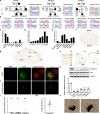TMEM151A variants cause paroxysmal kinesigenic dyskinesia
- PMID: 34518509
- PMCID: PMC8437987
- DOI: 10.1038/s41421-021-00322-w
TMEM151A variants cause paroxysmal kinesigenic dyskinesia
Erratum in
-
Author Correction: TMEM151A variants cause paroxysmal kinesigenic dyskinesia.Cell Discov. 2021 Oct 28;7(1):102. doi: 10.1038/s41421-021-00345-3. Cell Discov. 2021. PMID: 34711800 Free PMC article. No abstract available.
Conflict of interest statement
The authors declare no competing interests.
Figures

References
Publication types
Grants and funding
LinkOut - more resources
Full Text Sources
Molecular Biology Databases

